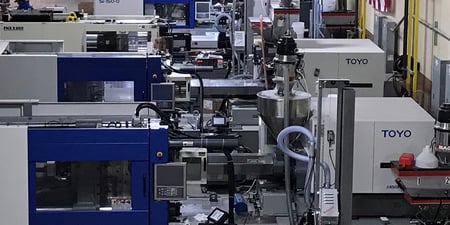 As a medical plastics manufacturer, you likely rely on high-volume output in an effort to surpass budgeted profit margins. Special, thin-walled molds for medical plastics parts offer the advantage of high-volume product runs with short cycle times – a necessity since these applications run multiple colors.
As a medical plastics manufacturer, you likely rely on high-volume output in an effort to surpass budgeted profit margins. Special, thin-walled molds for medical plastics parts offer the advantage of high-volume product runs with short cycle times – a necessity since these applications run multiple colors.
However, numerous resin transitions, from thin-walled molding in particular, result in high scrap rates and production downtime that decimate your profit potential.
To achieve quick and easy resin transitions, you must implement a purging process that lessens or altogether eliminates scrap rates to keep production runs moving along. Fortunately, purging compounds have seen a lot of innovation in the last few years, resulting in grades that are specifically designed for thin-walled molding.
The most widely used plastic material in medical applications is PVC (followed by PE, PP, PS, Nylon, PET, PA, PC, ABS, PEEK and PU). As a versatile plastic, PVC has been used mostly in pre-sterilized, single-use medical applications for over 50 years.
According to PVC.org, various medical applications made from or containing PVC include the following:
- Containers for blood, urine continence and ostomy products
- Containers for intravenous solution-giving sets
- Heart and lung bypass sets
- Catheters and cannulae
- Tubing for dialysis, endotracheal, feeding and pressure monitoring
- Surgical and examination gloves
- Inflatable splints
- Inhalation masks
- Blister packs for pills and tablets
Because clear PVC resins are used for high-cavity, thin-walled molding, there are a few things to keep in mind when it comes to purchasing the right purging compound:
- Low-temperature PVC resins also require a low-temperature grade purging compound.
- For high-temperature resins, such as PEEK, you need a thermally stable, high-temperature grade of purging compound for an effective cleaning.
Please note: Purging compounds are not regulated by the FDA. As such, most purging compound suppliers recommend only using the product for non-invasive medical applications. For invasive medical applications, purging compounds should only be used as part of a screw pull and manual cleaning/inspection. However, make sure to check with your purging compound supplier if the product can be used at all since the policy may vary by supplier.
Purchasing the right purging compound for your medical plastics processing is the first step in achieving faster production runs with minimal scrap rate. The purging procedure you develop is equally important for the most efficient resin transitions.
That’s why it is recommended you partner with a purging compound supplier who provides you with ample guidelines, step-by-step instructions and training for your crew. This multi-pronged approach to developing proper purging procedures is the only way to optimize the process.
Ready to achieve quick resin transitions for your medical plastics processing? Learn how purging compounds and process efficiency work in tandem.







Comments